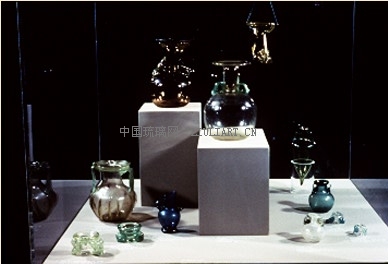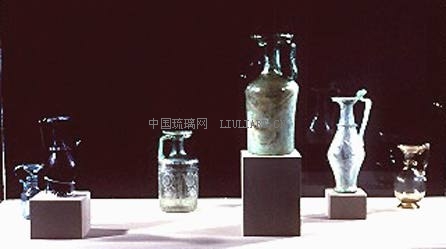The Kelsey Museum holds a unique position with respect to museums in the United States which have extensive collections of ancient glass. Most of our glass is from excavations conducted by The University of Michigan in the 1920's and 1930's: specifically at Seleucia-on-the-Tigris in Iraq, Sepphoris in Palestine, Dime and Karanis in Egypt.
Of the glass that does not derive from controlled excavations, all but a few pieces came to the Museum in large groups from well-documented personal collections acquired long ago in the lands of origin of the objects: the Askren and Ruthven Collections from Egypt; the Kelsey and Gréau Collections primarily from Cologne; the De Criscio Collection from Puteoli, Italy; the Cesnola Collection from Cyprus; the Havemeyer Collection from Syria and Rome.
Thus, although we have neither an encyclopedic corpus of ancient glass nor a world-renown masterpiece such as the Populonia Bottle or the Portland Vase, still we occupy a special and important place in the area of glass studies.

Reflecting the traditional strengths of our collections more generally, the ancient glass in the Museum is essentially and specifically Roman glass. That is to say, it is glass produced within the Greater Mediterranean sphere from the first century B.C. to the seventh century A.D. (We shall justify this chronological definition shortly).
The single most important group of glass in the Kelsey Museum is that from Karanis in the Egyptian Fayoum (west of the Delta). In 1924, The University of Michigan purchased the collection of Dr. D. L. Askren (a long-time resident of the Fayoum). This corpus consisted of about 180 vessels which are universally acknowledged to have come from the site at Karanis, long ravaged by the area's "sebbakh" diggers (fertilizer entrepreneurs).
In that same year, The University began excavations at the site which lasted until 1935. These excavations yielded hundreds of complete vessels as well as thousands of fragments. Most of this material came to the Kelsey Museum as a result of divisions with the Egyptian Government.
The houses at Karanis had undergone successive occupation from the late third century B.C. up to the sixth century A.D. Thus, the glass uncovered there spans the Ptolemaic period through the period of the Roman Empire and the "late antique." With the exception of a small amount of luxury-ware imported from Alexandria -- that great Delta cosmopolis and center of artistic endeavor -- the quantities of glass from Karanis seem to have been made in the town itself. The stratigraphy of the site is not without its problems.
Furthermore, through the correlative analysis of dated coins and papyri found in direct association with the glass we can only establish the fact that, indeed, specific vessels were in use during the periods defined by the dated material. Establishing dates for the manufacture of the glass is another matter entirely. Because the glass at Karanis was highly prized and was passed on from one generation to another, contextual associations -- while of great interest in other ways -- can be misleading for the archaeologist bent on fixing precise developmental schemata for ancient glass.
In 1936, D. B. Harden published a monumental catalogue of the glass excavated at Karanis in the first five seasons (1924/25-1928/29). Fully aware of the difficulties and limitations alluded to above, Harden produced a work of scholarship which remains one of the key building blocks for the construction of a history of Roman glass.

The material deserves continuing scholarly reappraisal in order to integrate it with discoveries made in other areas during the last half-century. By the same token, the publication of a scholarly catalogue of the Karanis glass from the later years of the campaign is a priority item on the Museum's agenda.
This exhibition does not, of course, pretend to accomplish either of these long-term goals in a systematic way -- even though we have considered recent scholarship and have made use of many previously unpublished glasses in the Museum. Rather, our aim here is to suggest the cultural significance of glass in the world of Rome from the period of Rome's ascendancy as a unifying and dominating world force to the period when historical events had set civilization upon a course of cultural regionalism.
This expansive temporal parameter for the "Roman" period enables us to view the material evidence as part of a humanistic continuum that certainly did not unravel with the conversion of Constantine or the rise of Byzantium. So too, geographically, this world of Rome that we wish to describe through its glass is more extensive than the traditional boundaries of power would suggest. It embraced the vastness of Asia beyond the strict confines of imperial domain -- as initiatives of trade and diplomacy linked West with East across the land and maritime Silk Routes.
The glass produced in this orb of interconnectedness captured the imaginations of contemporary poets, painters, and students of the natural sciences. Their testimony supplies valuable documentation of the forms and uses of glass. Furthermore, the paintings and discussions of glass left to us by the world of Rome reawaken in us a sense of the magical and contradictory essences of glass: its ability to be at once either heavy or light; sturdy or fragile; opaque or translucent; colorful or colorless; refracting or reflecting. Thus, the story of glass we shall offer here juxtaposes actual antiquities with the ancients' perceptions of them.
In view of this aim, the glass from Karanis is truly a treasure for it was recovered from the homes or ordinary people: unearthed along with their money, their tax rolls, their cult objects, cooking pots, and toys. Some of the glass was found tucked away in hiding places, such as the two Alexandrian goblets stacked one atop the other in a hole in a window sill covered by a ceramic pot lid. These goblets were created at least 100 years before the period of their final use in the house. St. Augustine's words ring true here:
Are we not frailer than if we were of glass? For even if glass is fragile, yet if cared for, it lasts a long time, and you find grandsons and great-grandsons drinking out of the cups of their grandfathers and great-grandfathers. Such fragile objects have been preserved throughout the years. (St. Augustine Sermon XVIII.7)
And indeed, it is as if the excavation photo documenting the discovery of the two heirlooms had been staged deliberately to contrast the fragility of the flesh with the durability of well-tended antiques!
Moving from the sublime to the mundane, we come upon hoards of glass which suggest a more cavalier attitude toward the glorious medium. Something like the modern custard dish that is usurped for paper clip storage is the rather dignified beaker which was found inelegantly stuffed with a crumpled wad of linen and two bone pins. The family inhabiting house B 121 at Karanis evidently had a distinct penchant for innovative uses of their glass containers.
In the same hoard together with the beaker was found a conical vessel of the type usually interpreted as a lamp for suspension. But this "lamp" seems to have acquired a new function on an even lighter side of life. It contained four bone dice. The moral of this story is that the functional analysis of material evidence is necessarily a game of chance -- dependent ultimately upon the disconcertingly capricious resourcefulness of the people behind the objects.
|




